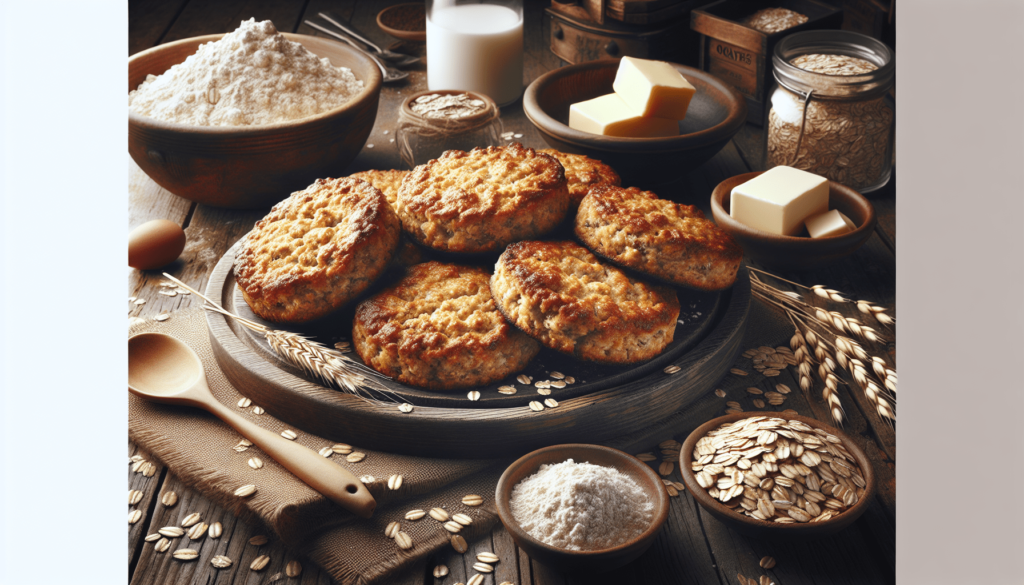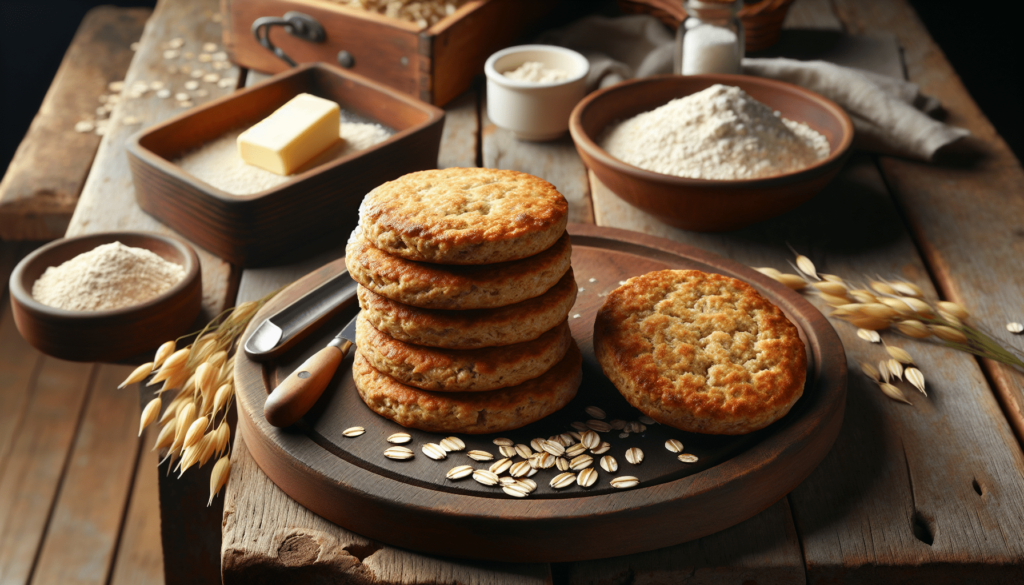If you’re craving a wholesome and delicious treat, look no further than this Oat Cakes Recipe. Made with simple ingredients and bursting with flavor, these oat cakes are the perfect combination of crunchy and moist. Whether you enjoy them as a quick breakfast or a satisfying snack, you’ll love the nutty and hearty taste that the oats bring to each bite. Follow this easy recipe to create a batch of these delectable oat cakes that are sure to become a family favorite.

Ingredients
To make delicious oat cakes, you will need the following ingredients:
Oats
Oats are the star of the show when it comes to oat cakes. Rolled oats provide a hearty and chewy texture, perfect for these tasty treats.
Flour
Flour is needed to bind the ingredients together and give the oat cakes structure. You can use all-purpose flour or whole wheat flour, depending on your preference.
Sugar
A touch of sweetness is added to the oat cakes with sugar. You can use white or brown sugar, whichever you prefer or have on hand.
Baking Powder
Baking powder is the leavening agent that helps the oat cakes rise and become light and fluffy. Make sure to check the expiration date to ensure its effectiveness.
Salt
A pinch of salt helps to enhance the flavors in the oat cakes and balance out the sweetness.
Butter
Butter provides richness and flavor to the oat cakes. Make sure to use cold butter and cut it into small pieces before adding it to the dough.
Milk
Milk is needed to bring all the ingredients together and create a dough. You can use any type of milk you prefer, such as cow’s milk, almond milk, or oat milk.
Preparation
To ensure your oat cakes turn out perfectly, follow these simple steps:
Preheat the oven
Before you begin preparing the oat cakes, preheat your oven to a temperature of 375°F (190°C). This will ensure that the oat cakes bake evenly and golden brown.
Mix the dry ingredients
In a large bowl, combine the oats, flour, sugar, baking powder, and salt. Mix well until all the ingredients are evenly distributed. This step ensures that the dry ingredients are thoroughly incorporated before adding the wet ingredients.
Add the butter
Add the cold, diced butter to the bowl with the dry ingredients. Using your fingertips or a pastry cutter, rub the butter into the dry mixture until it resembles coarse crumbs. This helps create a flaky texture in the oat cakes.
Incorporate the milk
Slowly pour in the milk while gently stirring the mixture. Mix until a dough forms. Be careful not to overmix, as this can result in tough oat cakes. The dough should be slightly sticky but manageable.
Knead the dough
Transfer the dough onto a lightly floured surface and gently knead it a few times to ensure all the ingredients are properly combined. Avoid excessive kneading, as this can lead to dense oat cakes.
Shape the oat cakes
Roll out the dough to a thickness of about 1/4 inch (0.6 cm). Use a round cookie cutter or the rim of a glass to cut out the oat cakes. Alternatively, you can shape the dough into small rounds or squares by hand.
Bake the oat cakes
Place the oat cakes onto a baking sheet lined with parchment paper. Bake in the preheated oven for approximately 15-20 minutes, or until they are golden brown and firm to the touch. Allow the oat cakes to cool on a wire rack before serving.
Variations
Add some excitement to your oat cakes with these delicious variations:
Fruit and Nut Oat Cakes
To make fruit and nut oat cakes, add a handful of dried fruits, such as raisins, cranberries, or chopped apricots, and a sprinkle of chopped nuts, such as almonds or walnuts, to the dough. This adds a burst of fruity sweetness and a pleasant crunch to your oat cakes.
Savory Herb Oat Cakes
For a savory twist, add herbs and spices to the oat cake dough. Finely chop fresh herbs like rosemary, thyme, or chives and mix them into the dough. You can also experiment with spices like garlic powder, onion powder, or paprika to add extra flavor.
Chocolate Chip Oat Cakes
For a decadent treat, add a handful of chocolate chips to the oat cake dough. The melty chocolate bits will add a touch of richness and indulgence to your oat cakes. This variation is perfect for chocolate lovers!
Serving Suggestions
Whether enjoyed plain or dressed up, oat cakes can be a delightful snack or breakfast option. Here are some serving suggestions to consider:
Plain
Oat cakes pack a lot of flavor on their own. Enjoy them plain and savor the wholesome goodness of oats and warm spices.
With butter and honey
Spread a thin layer of butter on your oat cake and drizzle it with a touch of honey. The combination of creamy butter and sweet honey adds a luscious and comforting touch to the oat cakes.
With jam or preserves
Top your oat cakes with your favorite jam or preserves. The sweet and fruity spread pairs perfectly with the natural nuttiness of oats, creating a delicious flavor combination.
With cheese and fruit
For a more filling and savory option, pair oat cakes with cheese and sliced fruit. The creamy cheese and fresh fruit add a delightful contrast to the hearty oat cakes, making for a satisfying and balanced meal.

Storage
To ensure your oat cakes stay fresh and tasty, follow these storage guidelines:
Allow the oat cakes to cool completely
Before storing the oat cakes, make sure they are completely cool. This prevents moisture buildup, which can lead to a soggy texture.
Place them in an airtight container
Transfer the cooled oat cakes to an airtight container. This will help maintain their freshness and protect them from any environmental moisture.
Store them in a cool, dry place
Keep your oat cakes in a cool and dry place, such as a pantry or cupboard. Avoid storing them in direct sunlight or in areas prone to humidity, as this can affect their texture and taste.
Tips and Tricks
Here are some helpful tips and tricks to enhance your oat cake baking experience:
Use old-fashioned rolled oats
To achieve the best texture and flavor, opt for old-fashioned rolled oats. They provide a chewy and substantial bite that is essential to a good oat cake.
Experiment with different flours
While the traditional oat cake recipe calls for all-purpose flour, feel free to experiment with different flours, such as whole wheat, almond, or oat flour. This allows you to customize the recipe to your dietary preferences or to add extra nutritional value.
Adjust the sweetness to your taste
If you prefer your oat cakes to be sweeter, feel free to increase the amount of sugar in the recipe. Likewise, if you want a less sweet version, you can reduce the sugar or even omit it altogether.
Nutritional Benefits
Oat cakes offer a range of nutritional benefits, making them a healthy choice for a snack or breakfast. Here are some of the benefits you can expect:
High in fiber
Oats are rich in dietary fiber, which aids in digestion and helps maintain a healthy digestive system. Eating oat cakes can contribute to your daily fiber intake and promote overall gut health.
Good source of vitamins and minerals
Oats contain various vitamins and minerals, including vitamin B-6, iron, magnesium, and zinc. These nutrients play essential roles in maintaining overall health and wellbeing.
Low in saturated fat and cholesterol
Oat cakes are a low-fat and low-cholesterol option, making them a healthier alternative to many other baked goods. They can be enjoyed guilt-free as part of a balanced diet.
History of Oat Cakes
Oat cakes have a rich history, especially in Scotland, where they originated. They have been a traditional food for centuries and are often associated with celebrations and ceremonies. Oat cakes were once a staple food in Scottish households and were enjoyed as a versatile and nutritious snack.
Health Considerations
When making or consuming oat cakes, it’s important to consider certain health factors:
Gluten-free options for those with sensitivities
If you have a gluten sensitivity or intolerance, you can still enjoy oat cakes by using certified gluten-free oats and gluten-free flour in the recipe. Ensure that all the other ingredients used are also gluten-free.
Allergy concerns with oats
While oats are naturally gluten-free, they can sometimes be cross-contaminated with gluten-containing grains during processing. If you have a severe gluten allergy, make sure to choose oats that are specifically labeled as gluten-free to avoid any potential reactions.
Conclusion
In conclusion, making oat cakes is an easy and versatile recipe that can be enjoyed by anyone. These delicious treats offer a healthy and delicious snack or breakfast option. With various flavor variations and serving suggestions, oat cakes can cater to different tastes and preferences. Whether you opt for a classic oat cake with butter and honey or explore more adventurous options, you’ll delight in the natural goodness and nutty flavors of these oat-based delights. So, gather your ingredients and give this simple recipe a try – you won’t be disappointed!


